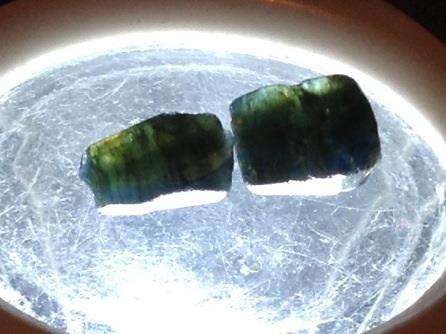Twapster
Peter
This one has been bugging me. My last hunt revealed what I beleived to be a "water worn" sapphire, only to find "shards" of several other sapphires in the same spot. My first reaction was...id like to find where daddy was for the nice broken off pieces were, and why they appeared not water worn.
Then doing some research on how Sapphires are formed, how they are deposited and how far they travel etc to get a better understanding of where to look for them, im now not beleiving theory that they have travelled at all.
http://www.australiansapphire.com/sapphire_formation_theory.htm
The above article validates some of the questions that were in my head
Every rockhound knows that if you put a sapphire crystal in a tumbling machine with grinding compound and let it run for even I0 weeks the sapphire will probably still have it's corners still visible. If you do the sum for a 500mm diameter tumbler doing 40 revs per minute, for 60 mins/hour, 24 hrs/day, 7days/week, for 10 weeks - you will find that your sapphire has traveled some 6,000 kilometres in a dry abrasive environment - but is still not reduced to a round pebble.
and this part
Shape of Sapphire Crystals.
Conventional wisdom has it that sapphire forms in the shape of double-terminated "dogs teeth", or at very least a single dogs tooth form.
Having studied tens of thousands of pieces of sapphire from out mining operations, Jenny can assure you that very little of the sapphire found is actually broken, and that most of the pieces actually are the entire crystal as it was formed.
This "as formed" crystal shape can be chunky, but irregular, or flat like a sapphire platelet - but they all are fully developed crystals without being broken off a larger piece. Many miners, when finding a large piece which is apparently the broken-off centre section of a dogs tooth have been known to exclaim that they wish that they could find the rest of the crystal - when , in reality, they do have the entire crystal.
and this point
We tried some mining techniques which would have had conventional miners questioning our sanity - but they worked, and we found sapphire! We left the alluvial systems and started mining the huge deposits of volcanic ash which blanket the area - and we found excellent sapphire.
I believe that the sapphire was produced from a large number of smaller vents which are located throughout the sapphire producing areas, and that the sapphire never moves, any significant distance from its point of origin at the surface.
Anyway, some interesting reading. Im wondering if anyone has noted these sort of findings in their own gem travels which make you question where and how you should be digging etc.
Then doing some research on how Sapphires are formed, how they are deposited and how far they travel etc to get a better understanding of where to look for them, im now not beleiving theory that they have travelled at all.
http://www.australiansapphire.com/sapphire_formation_theory.htm
The above article validates some of the questions that were in my head
Every rockhound knows that if you put a sapphire crystal in a tumbling machine with grinding compound and let it run for even I0 weeks the sapphire will probably still have it's corners still visible. If you do the sum for a 500mm diameter tumbler doing 40 revs per minute, for 60 mins/hour, 24 hrs/day, 7days/week, for 10 weeks - you will find that your sapphire has traveled some 6,000 kilometres in a dry abrasive environment - but is still not reduced to a round pebble.
and this part
Shape of Sapphire Crystals.
Conventional wisdom has it that sapphire forms in the shape of double-terminated "dogs teeth", or at very least a single dogs tooth form.
Having studied tens of thousands of pieces of sapphire from out mining operations, Jenny can assure you that very little of the sapphire found is actually broken, and that most of the pieces actually are the entire crystal as it was formed.
This "as formed" crystal shape can be chunky, but irregular, or flat like a sapphire platelet - but they all are fully developed crystals without being broken off a larger piece. Many miners, when finding a large piece which is apparently the broken-off centre section of a dogs tooth have been known to exclaim that they wish that they could find the rest of the crystal - when , in reality, they do have the entire crystal.
and this point
We tried some mining techniques which would have had conventional miners questioning our sanity - but they worked, and we found sapphire! We left the alluvial systems and started mining the huge deposits of volcanic ash which blanket the area - and we found excellent sapphire.
I believe that the sapphire was produced from a large number of smaller vents which are located throughout the sapphire producing areas, and that the sapphire never moves, any significant distance from its point of origin at the surface.
Anyway, some interesting reading. Im wondering if anyone has noted these sort of findings in their own gem travels which make you question where and how you should be digging etc.




